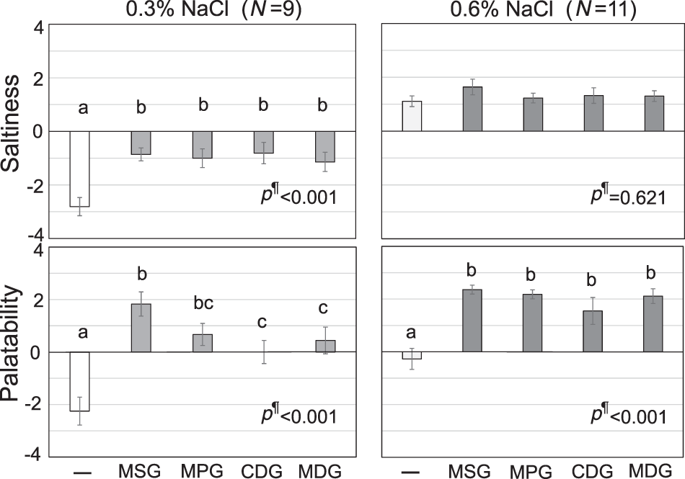当前位置:
X-MOL 学术
›
Hypertens. Res.
›
论文详情
Our official English website, www.x-mol.net, welcomes your
feedback! (Note: you will need to create a separate account there.)
Quantitative verification of the effect of using an umami substance (L-glutamate) to reduce salt intake
Hypertension Research ( IF 4.3 ) Pub Date : 2020-02-18 , DOI: 10.1038/s41440-020-0399-z Rieko Morita 1 , Masanori Ohta 1 , Hitomi Hayabuchi 2 , Shoji Fujitani 3 , Shintaro Yoshida 3 , Hideki Matsumoto 3 , Takuya Tsuchihashi 4
Hypertension Research ( IF 4.3 ) Pub Date : 2020-02-18 , DOI: 10.1038/s41440-020-0399-z Rieko Morita 1 , Masanori Ohta 1 , Hitomi Hayabuchi 2 , Shoji Fujitani 3 , Shintaro Yoshida 3 , Hideki Matsumoto 3 , Takuya Tsuchihashi 4
Affiliation

|
The importance of reducing sodium intake as a practical preventative measure against cardiovascular disease and stroke is becoming widely known [1–4]. According to the guidelines for hypertension management, a goal should be to set the salt intake to <6 g/day [5]. However, efforts to promote salt reduction in Japan is insufficient. Many studies have reported that the use of glutamate is an effective way to reduce salt intake without decreasing the palatability of food [6–8]. However, the results of previous studies may have been influenced by the flavor and taste of the soup itself [9–11], and few studies have considered the effects of free glutamate concentration [12, 13]. Yamaguchi et al. used water as a base medium and reported the interaction between monosodium glutamate (MSG) and the four basic tastes [14]. In their study, solutions with sodium chloride (NaCl) in the range of 0–3.4 × 10 mol/L and MSG in the range of 0–8.0 × 10 mol/L (0–2.0% NaCl, 0–1.3% MSG) were evaluated. However, few basic research studies have examined the effects of MSG added to water as the base medium with concentrations ≤0.9% NaCl, which is similar to that in typical soups. In this study, we used distilled water with no taste and no odor as the medium to examine the possibility of reducing salt in ordinary soup preparations (0.9% NaCl). We validated the changes in the taste of the NaCl solution with the addition of umami substances (L-glutamates) using a sensory evaluation test and quantitative analysis. We also compared the effects of four glutamates that have different counter-ions. The participants were healthy females in a registered dietitian training course at a university, and there were 11 participants (aged 22–64; mean ± SD 30.5 ± 3.7) in Experiment 1 and 11 participants (aged 20–65; mean ± SD 28.7 ± 12.6) in Experiment 2. In Experiment 1, 48 types of NaCl/MSG mixtures (0.2, 0.3, 0.4, 0.5, 0.6, 0.7, 0.8, and 0.9% NaCl and 0.1, 0.2, 0.3, 0.4, 0.5, and 0.6% MSG) were tasted. The participants tasted one series of test solutions with a set MSG concentration on each testing day. On the test day, the participants tasted eight different NaCl/MSG mixtures in order from the lowest to highest NaCl concentrations. In Experiment 2, the sensory evaluation was a single-blind test. Ten types of NaCl/glutamate solutions consisting of 0.3 or 0.6% NaCl alone and 0.3 or 0.6% NaCl plus one of four glutamates, MSG, monopotassium glutamate (MPG), calcium diglutamate (CDG), and magnesium diglutamate (MDG), were evaluated. The free glutamate concentration of the test samples was set at 1.6 × 10 mol/ L. The participants tasted the 0.3% NaCl mixture on day one and the 0.6% NaCl mixture after 2 weeks. Sensory evaluation was performed between 10:30 am and 11:30 am. Each solution was tested twice by the participants. Saltiness and palatability were evaluated using a scale with 21 possible ratings. The range was between −5 and +5 in 0.5-point increments. The evaluation baseline (0) of saltiness and palatability was set as the 0.5% NaCl solution. The saltiness of the distilled water was rated as −5, and that of 1.0% NaCl was rated as +5. The average rating of the two evaluations was calculated for each participant. The participants were asked to rinse their mouths with water before and between the evaluations of each sample. To determine whether differences existed in the average ratings of the eight different NaCl mixtures for each MSG concentration in Experiment 1 and to determine whether differences existed in the average ratings of the five different NaCl/glutamate mixtures in Experiment 2, repeated-measures * Masanori Ohta m-ohta@fwu.ac.jp
中文翻译:

定量验证使用鲜味物质(L-谷氨酸)减少盐摄入量的效果
减少钠摄入量作为预防心血管疾病和中风的实用措施的重要性已广为人知[1-4]。根据高血压管理指南,目标应该是将盐摄入量设置为 <6 g/天 [5]。然而,在日本推动减盐的努力还不够。许多研究报告称,使用谷氨酸盐是减少盐摄入量而不降低食物适口性的有效方法 [6-8]。然而,之前的研究结果可能受到汤本身风味和味道的影响[9-11],很少有研究考虑游离谷氨酸浓度的影响[12, 13]。山口等人。使用水作为基础介质,并报告了味精 (MSG) 与四种基本口味之间的相互作用 [14]。在他们的研究中,评估了氯化钠 (NaCl) 范围为 0–3.4 × 10 mol/L 和味精范围为 0–8.0 × 10 mol/L(0–2.0% NaCl,0–1.3% MSG)的溶液。然而,很少有基础研究研究将味精添加到作为基础介质的水中,浓度 ≤ 0.9% NaCl,这与典型汤中的浓度相似。在本研究中,我们使用无味无味的蒸馏水作为介质,研究降低普通汤料(0.9% NaCl)中盐分的可能性。我们使用感官评价测试和定量分析验证了添加鲜味物质(L-谷氨酸盐)后 NaCl 溶液的味道变化。我们还比较了四种具有不同反离子的谷氨酸盐的影响。参与者是在一所大学注册营养师培训课程的健康女性,实验 1 有 11 名参与者(22-64 岁;平均±标准差 30.5±3.7),实验 2 有 11 名参与者(20-65 岁;平均±标准差 28.7±12.6)。在实验 1 中,48 种 NaCl/品尝味精混合物(0.2、0.3、0.4、0.5、0.6、0.7、0.8 和 0.9% NaCl 和 0.1、0.2、0.3、0.4、0.5 和 0.6% 味精)。参与者在每个测试日品尝一系列具有设定 MSG 浓度的测试溶液。在测试当天,参与者按照从最低到最高 NaCl 浓度的顺序品尝了八种不同的 NaCl/MSG 混合物。在实验2中,感官评价是单盲测试。评估了 10 种类型的 NaCl/谷氨酸盐溶液,它们由单独的 0.3% 或 0.6% NaCl 和 0.3% 或 0.6% NaCl 加上四种谷氨酸盐中的一种组成,即味精、谷氨酸单钾 (MPG)、二谷氨酸钙 (CDG) 和二谷氨酸镁 (MDG) . 测试样品的游离谷氨酸浓度设定为 1.6 × 10 mol/L。参与者在第一天品尝 0.3% NaCl 混合物,2 周后品尝 0.6% NaCl 混合物。感官评估在上午 10:30 至上午 11:30 之间进行。参与者对每种解决方案进行了两次测试。使用具有 21 个可能等级的量表评估咸味和适口性。范围在 -5 和 +5 之间,增量为 0.5 点。咸味和适口性的评价基线(0)设定为0.5% NaCl溶液。蒸馏水的咸度定为-5,1.0% NaCl的咸度定为+5。计算每个参与者的两次评估的平均评分。参与者被要求在评估每个样品之前和之间用水漱口。
更新日期:2020-02-18
中文翻译:

定量验证使用鲜味物质(L-谷氨酸)减少盐摄入量的效果
减少钠摄入量作为预防心血管疾病和中风的实用措施的重要性已广为人知[1-4]。根据高血压管理指南,目标应该是将盐摄入量设置为 <6 g/天 [5]。然而,在日本推动减盐的努力还不够。许多研究报告称,使用谷氨酸盐是减少盐摄入量而不降低食物适口性的有效方法 [6-8]。然而,之前的研究结果可能受到汤本身风味和味道的影响[9-11],很少有研究考虑游离谷氨酸浓度的影响[12, 13]。山口等人。使用水作为基础介质,并报告了味精 (MSG) 与四种基本口味之间的相互作用 [14]。在他们的研究中,评估了氯化钠 (NaCl) 范围为 0–3.4 × 10 mol/L 和味精范围为 0–8.0 × 10 mol/L(0–2.0% NaCl,0–1.3% MSG)的溶液。然而,很少有基础研究研究将味精添加到作为基础介质的水中,浓度 ≤ 0.9% NaCl,这与典型汤中的浓度相似。在本研究中,我们使用无味无味的蒸馏水作为介质,研究降低普通汤料(0.9% NaCl)中盐分的可能性。我们使用感官评价测试和定量分析验证了添加鲜味物质(L-谷氨酸盐)后 NaCl 溶液的味道变化。我们还比较了四种具有不同反离子的谷氨酸盐的影响。参与者是在一所大学注册营养师培训课程的健康女性,实验 1 有 11 名参与者(22-64 岁;平均±标准差 30.5±3.7),实验 2 有 11 名参与者(20-65 岁;平均±标准差 28.7±12.6)。在实验 1 中,48 种 NaCl/品尝味精混合物(0.2、0.3、0.4、0.5、0.6、0.7、0.8 和 0.9% NaCl 和 0.1、0.2、0.3、0.4、0.5 和 0.6% 味精)。参与者在每个测试日品尝一系列具有设定 MSG 浓度的测试溶液。在测试当天,参与者按照从最低到最高 NaCl 浓度的顺序品尝了八种不同的 NaCl/MSG 混合物。在实验2中,感官评价是单盲测试。评估了 10 种类型的 NaCl/谷氨酸盐溶液,它们由单独的 0.3% 或 0.6% NaCl 和 0.3% 或 0.6% NaCl 加上四种谷氨酸盐中的一种组成,即味精、谷氨酸单钾 (MPG)、二谷氨酸钙 (CDG) 和二谷氨酸镁 (MDG) . 测试样品的游离谷氨酸浓度设定为 1.6 × 10 mol/L。参与者在第一天品尝 0.3% NaCl 混合物,2 周后品尝 0.6% NaCl 混合物。感官评估在上午 10:30 至上午 11:30 之间进行。参与者对每种解决方案进行了两次测试。使用具有 21 个可能等级的量表评估咸味和适口性。范围在 -5 和 +5 之间,增量为 0.5 点。咸味和适口性的评价基线(0)设定为0.5% NaCl溶液。蒸馏水的咸度定为-5,1.0% NaCl的咸度定为+5。计算每个参与者的两次评估的平均评分。参与者被要求在评估每个样品之前和之间用水漱口。











































 京公网安备 11010802027423号
京公网安备 11010802027423号